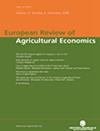红色、黄色还是绿色?消费者对食品的选择取决于标签设计吗?
IF 3.3
2区 经济学
Q2 AGRICULTURAL ECONOMICS & POLICY
引用次数: 13
摘要
通过一项既定偏好调查,我们调查了消费者在多大程度上愿意做出更昂贵的食品消费选择,以减少对健康、环境和动物福祉的损害。特别是,我们通过比较红绿灯和灰度标签以及纯文本描述,研究了标签的图形设计如何影响选择行为。我们发现,红绿灯似乎加强了受访者对避免最糟糕的集体属性(如气候影响或抗生素使用)的偏好,而绿色则加强了对更私人属性(即健康)的偏好。平均而言,绿色标签与红色标签相比的价格溢价为52 健康百分比,64 %用于动物福利和抗生素,以及20 %。本文章由计算机程序翻译,如有差异,请以英文原文为准。
Red, yellow, or green? Do consumers’ choices of food products depend on the label design?
Using a stated preference survey, we investigate to what extent consumers are willing to make costlier food consumption choices to decrease damages to health, the environment, and animal well-being. In particular, we investigate how the graphic design of the labels affects choice behaviour by comparing traffic–light and greyscale labels and plain-text description with each other. We found that the red colour in traffic lights seems to strengthen respondents’ preferences for avoiding the worst level of a collective attribute such as climate impact or antibiotics use, while the green colour strengthened preferences for the more private attribute, namely healthiness. On average, the price premiums for a green label compared with a red label is 52 per cent for healthiness, 64 per cent for both animal welfare and antibiotics, and 20 per cent for climate impact.
求助全文
通过发布文献求助,成功后即可免费获取论文全文。
去求助
来源期刊

European Review of Agricultural Economics
管理科学-农业经济与政策
CiteScore
6.60
自引率
5.90%
发文量
25
审稿时长
>24 weeks
期刊介绍:
The European Review of Agricultural Economics serves as a forum for innovative theoretical and applied agricultural economics research.
The ERAE strives for balanced coverage of economic issues within the broad subject matter of agricultural and food production, consumption and trade, rural development, and resource use and conservation. Topics of specific interest include multiple roles of agriculture; trade and development; industrial organisation of the food sector; institutional dynamics; consumer behaviour; sustainable resource use; bioenergy; agricultural, agri-environmental and rural policy; specific European issues.
Methodological articles are welcome. All published papers are at least double peer reviewed and must show originality and innovation. The ERAE also publishes book reviews.
 求助内容:
求助内容: 应助结果提醒方式:
应助结果提醒方式:


